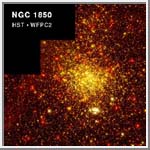|
COMETS EARTH JUPITER KUIPER BELT MARS MERCURY METEORITES NEPTUNE OORT CLOUD PLUTO SATURN SOLAR SYSTEM SPACE SUN URANUS VENUS ORDER PRINTS
PHOTO CATEGORIES SCIENCEVIEWS AMERICAN INDIAN AMPHIBIANS BIRDS BUGS FINE ART FOSSILS THE ISLANDS HISTORICAL PHOTOS MAMMALS OTHER PARKS PLANTS RELIGIOUS REPTILES SCIENCEVIEWS PRINTS
|
Related Document
Download Options
This NASA Hubble Space Telescope (HST) image shows rich detail, previously only seen in neighboring star birth regions, in a pair of star clusters 166,000 light-years away in the Large Magellanic Cloud (LMC), in the southern constellation Doradus. The field of view is 130 light-years across and was taken with the Wide Field Planetary Camera 2. HST's unique capabilities -- ultraviolet sensitivity, ability to see faint stars, and high resolution -- have been utilized fully to identify three separate populations in this concentration of nearly 10,000 stars down to the 25th magnitude (more that twice as many as can be seen over the entire sky with the naked eye on a clear night on Earth). The field of view is only 130 light-years across. Previous observations with ground-based telescopes resolve less than 1,000 stars in the same region. About 60 percent of the stars belong to the dominant yellow cluster called NGC 1850, which is estimated to be 50 million years old. A scattering of white stars in the image are massive stars that are only about 4 million years old and represent about 20 percent of the stars in the image. (The remainder are field stars in the LMC.) Besides being much younger, the white stars are much more loosely distributed than the yellow cluster. The significant difference between the two cluster ages suggests these are two separate star groups that lie along the same line of sight. The younger, more open cluster probably lies 200 light-years beyond the older cluster. If it were in the foreground, then dust contained in the white cluster would obscure stars in the older yellow cluster. To observe two well-defined star populations separated by such a small gap of space is unusual. This juxtaposition suggests that supernova explosions in the older cluster might have triggered the birth of the younger cluster. This color composite image is assembled from exposures taken in ultraviolet, visible, and near-infrared light. Yellow stars correspond to Main Sequence stars (like our Sun) with average surface temperatures of 6000 Kelvin; red stars are cool giants and supergiants (3500 K); white stars are hot young stars (25,000 K or more) that are bright in ultraviolet. Image use statement at the time this image was obtained. All of the HST images available via WWW and ftp may be used without restriction as long as credit information accompanies the picture. Credit usually includes the principal scientist responsible for the data, AURA/STScI, NASA and/or ESA, the European Space Agency. Specific credit information may be found in the captions accompanying the images as plain text files. The captions are available via links from the Web pages as well as separate files in the gif directory on the ftp server. |
